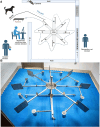Dogs can detect an odor profile associated with Staphylococcus aureus biofilms in cultures and biological samples
- PMID: 38414670
- PMCID: PMC10896932
- DOI: 10.3389/falgy.2024.1275397
Dogs can detect an odor profile associated with Staphylococcus aureus biofilms in cultures and biological samples
Abstract
Introduction: The study investigated the utilization of odor detection dogs to identify the odor profile of Staphylococcus aureus (S. aureus) biofilms in pure in vitro samples and in in vivo biosamples from animals and humans with S. aureus periprosthetic joint infection (PJI). Biofilms form when bacterial communities aggregate on orthopedic implants leading to recalcitrant infections that are difficult to treat. Identifying PJI biofilm infections is challenging, and traditional microbiological cultures may yield negative results even in the presence of clinical signs.
Methods: Dogs were trained on pure in vitro S. aureus biofilms and tested on lacrimal fluid samples from an in vivo animal model (rabbits) and human patients with confirmed S. aureus PJI.
Results: The results demonstrated that dogs achieved a high degree of sensitivity and specificity in detecting the odor profile associated with S. aureus biofilms in rabbit samples. Preliminary results suggest that dogs can recognize S. aureus volatile organic compounds (VOCs) in human lacrimal fluid samples.
Discussion: Training odor detection dogs on in vitro S. aureus, may provide an alternative to obtaining clinical samples for training and mitigates biosecurity hazards. The findings hold promise for culture-independent diagnostics, enabling early disease detection, and improved antimicrobial stewardship. In conclusion, this research demonstrates that dogs trained on in vitro S. aureus samples can identify the consistent VOC profile of PJI S. aureus biofilm infections. The study opens avenues for further investigations into a retained VOC profile of S. aureus biofilm infection. These advancements could revolutionize infectious disease diagnosis and treatment, leading to better patient outcomes and addressing the global challenge of antimicrobial resistance.
Keywords: Staphylococcus aureus; biofilm; canine detection; culture-negative infection; olfaction; periprosthetic joint infection (PJI); volatile organic compound (VOC).
© 2024 Ramos, Chang, Wilson, Gilbertie, Krieg, Parvizi, Chen, Otto and Schaer.
Conflict of interest statement
The authors declare that the research was conducted in the absence of any commercial or financial relationships that could be construed as a potential conflict of interest.
Figures
Similar articles
-
Genomics of Staphylococcus aureus and Staphylococcus epidermidis from Periprosthetic Joint Infections and Correlation to Clinical Outcome.Microbiol Spectr. 2022 Aug 31;10(4):e0218121. doi: 10.1128/spectrum.02181-21. Epub 2022 Jun 28. Microbiol Spectr. 2022. PMID: 35762769 Free PMC article.
-
Novel Insights into Staphylococcus aureus Deep Bone Infections: the Involvement of Osteocytes.mBio. 2018 Apr 24;9(2):e00415-18. doi: 10.1128/mBio.00415-18. mBio. 2018. PMID: 29691335 Free PMC article.
-
Staphylococcus aureus Aggregates on Orthopedic Materials under Varying Levels of Shear Stress.Appl Environ Microbiol. 2020 Sep 17;86(19):e01234-20. doi: 10.1128/AEM.01234-20. Print 2020 Sep 17. Appl Environ Microbiol. 2020. PMID: 32709721 Free PMC article.
-
Promising treatment strategies to combat Staphylococcus aureus biofilm infections: an updated review.Biofouling. 2020 Nov;36(10):1159-1181. doi: 10.1080/08927014.2020.1857743. Epub 2020 Dec 22. Biofouling. 2020. PMID: 33353409 Review.
-
Biofilms in Periprosthetic Joint Infections: A Review of Diagnostic Modalities, Current Treatments, and Future Directions.J Knee Surg. 2020 Feb;33(2):119-131. doi: 10.1055/s-0040-1701214. Epub 2020 Jan 14. J Knee Surg. 2020. PMID: 31935760 Review.
References
-
- Grimberg AW, Grupp TM, Elliott J, Melsheimer O, Jansson V, Steinbrück A. Ceramic coating in cemented primary total knee arthroplasty is not associated with decreased risk of revision due to early prosthetic joint infection. J Arthroplasty. (2021) 36(3):991–7. 10.1016/j.arth.2020.09.011 - DOI - PubMed
LinkOut - more resources
Full Text Sources


